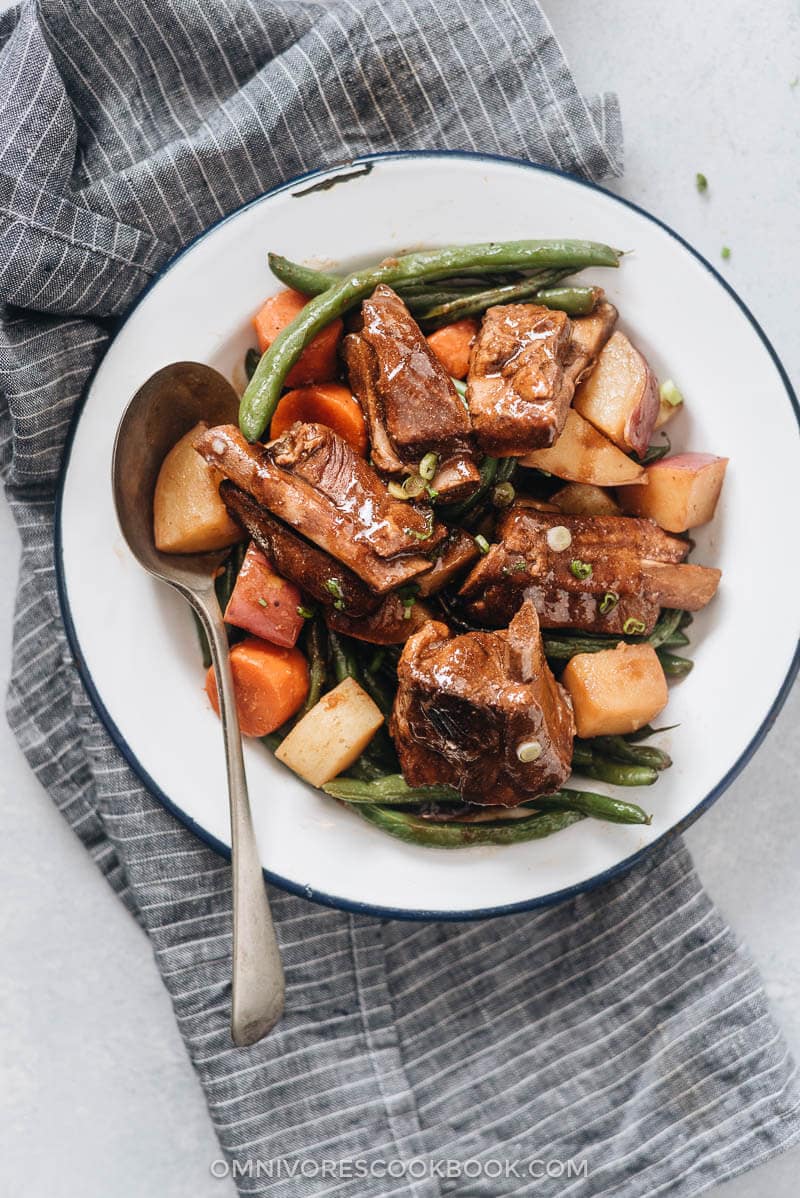
As a food blogger, I have the habit of constantly exploring new flavors and cooking techniques. However, there are certain habits that I rarely deviate from. For example, making braised pork ribs using the recipe passed down from my grandma, and serving it with steamed rice.
Whenever I serve this dish, I remember the good old times back in China. My mom used to pack my lunch box with some saucy braised ribs, steamed seven-grain rice, and a freshly made vegetable stir fry. Everything was made from scratch. I didn’t realize how lucky I was until I moved to the US, where I have to cook everything in my own kitchen if I want a family-style meal.
Just like with other family dishes, my mom never needed a recipe for this dish. When I asked her how to cook my favorite braised pork ribs, it took her forever to measure everything and pass me a recipe that was still ambiguous. Today, even though I can still taste a subtle difference between our renditions of the dish, I’m lucky to enjoy the taste of home often. My husband loves the dish so much and he said it is just as good as he remembered.
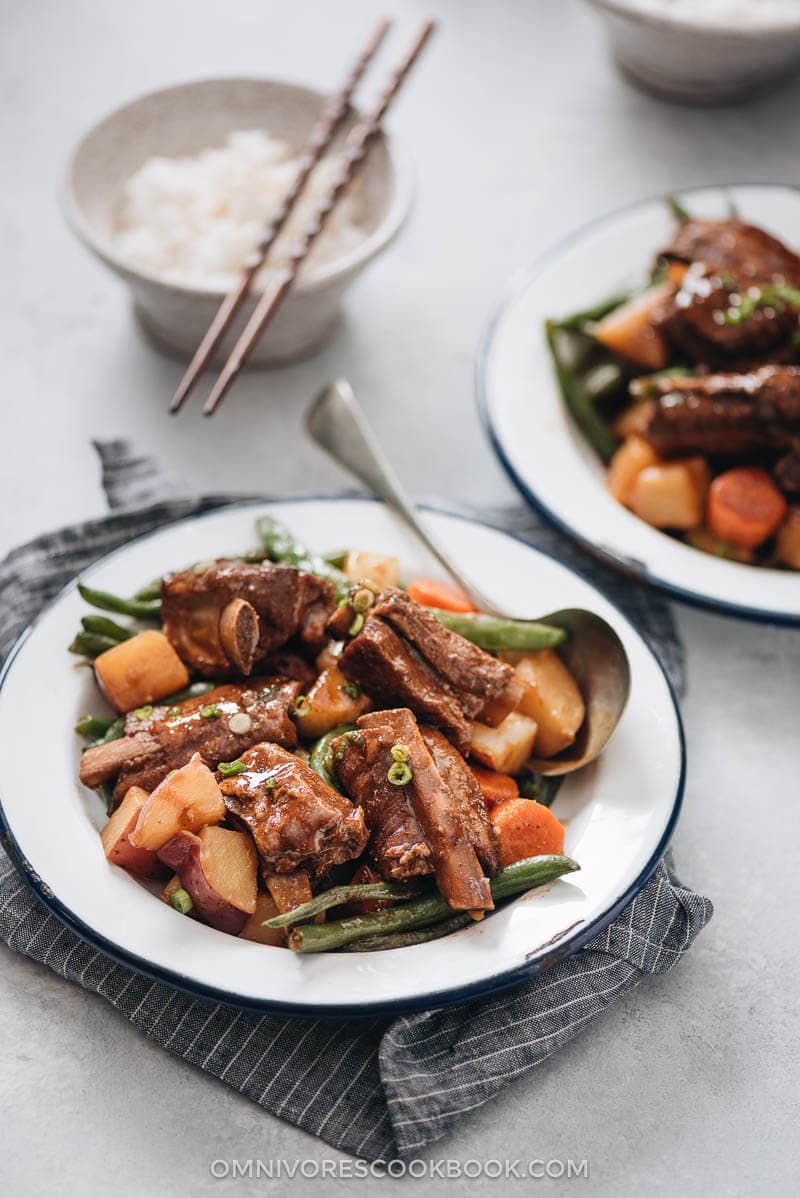
Braised pork ribs, my mom’s style
Compared to many recipes out there, my family does a few things differently, to make the cooking easier to approach and the results extra delicious.
(1) Blanch the ribs instead of browning them.
I’ve seen many braised meat recipes require a browning procedure, where you “seal the flavors” into the meat and create a good texture. Not in this recipe.
The browning process is messy, creating a lot of smoke and oil splatter. So my mom never browns the meat, but blanches it instead. You still get a great texture and flavor in the end, with tender, fall-off-the-bone pork, soaked in a scrumptious sauce.
(2) Add salty seasonings later.
My mom claims this method makes tenderer meat in a shorter cooking time.
You add only the ingredients that do not contain salt at the beginning. Adding fresh aromatics at the very beginning of cooking is crucial because it helps eliminate the gaminess of the pork and adds fragrance to the broth. On the other hand, adding salt too early will tighten up the pork and require a longer braising time. So always add soy sauce and salt when the braising is halfway finished, when the meat starts to turn soft, but still has enough time to absorb the flavor and the saltiness.
(3) The one secret ingredient that makes your dish “wow”
There is one ingredient in this recipe that you might not be able to obtain easily outside of China – the red fermented bean curd. It’s a preserved tofu product cooked with soy sauce, rice wine, and sesame oil. I call it Chinese cheese, since its texture is similar to that of soft cheese and its taste is a bit stinky. In this recipe, my mom uses red fermented bean curd to add a complex flavor to the sauce.
There are two types of fermented bean curd: white and red. The two have very distinct flavors. So, do not use the white type in this recipe. If you can’t find the red fermented bean curd or just don’t like its flavor, skip it. The pork will still taste very nice.
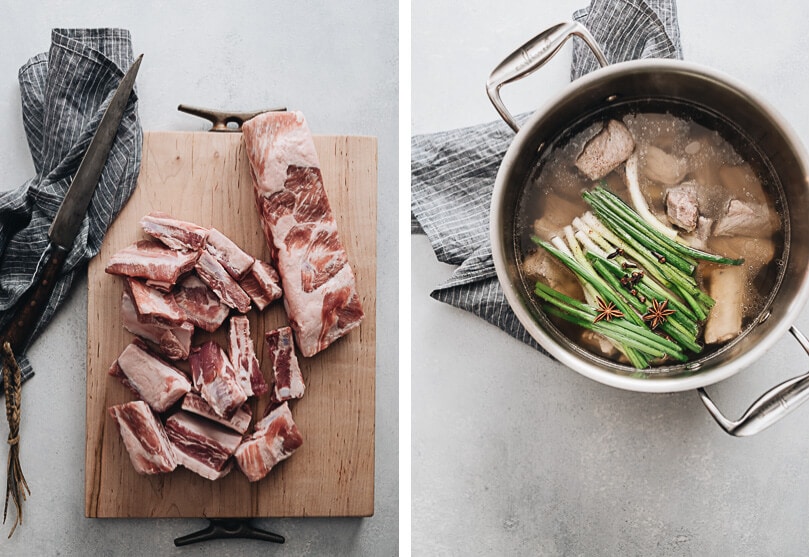
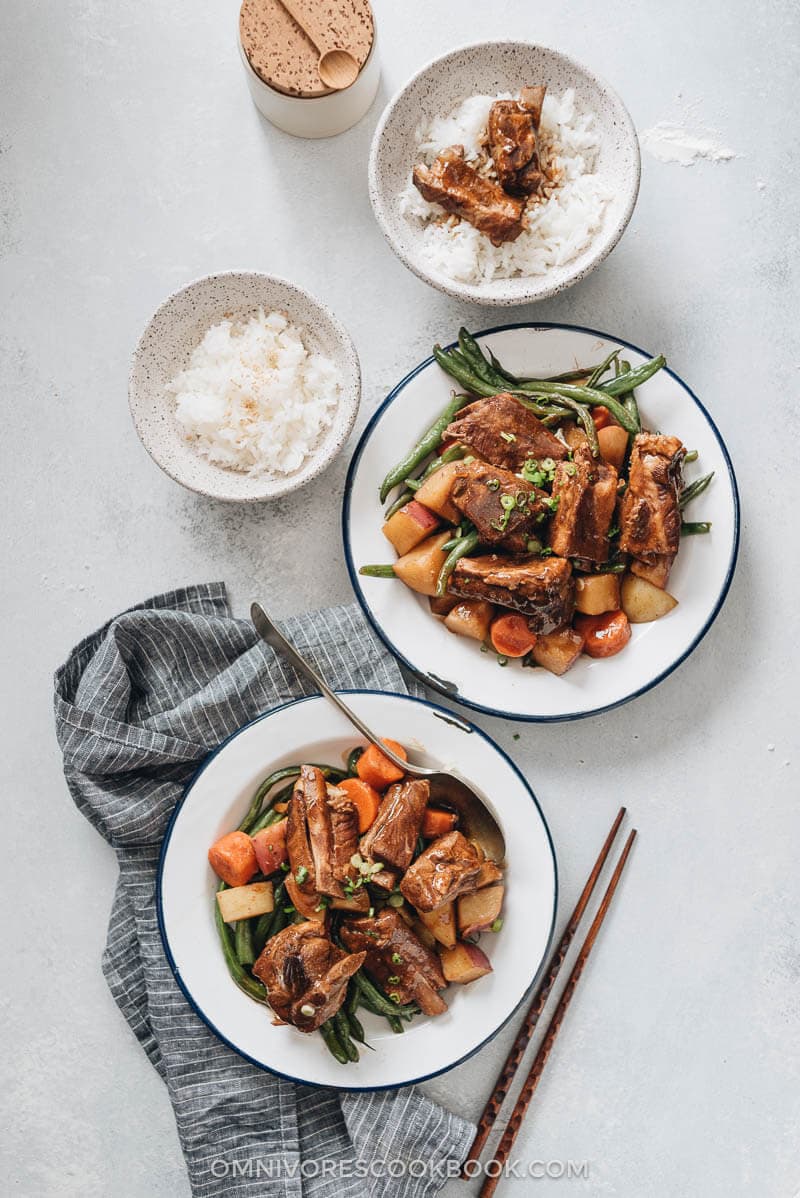
More cooking notes
Despite the fact that I’ve been following my mom’s recipe closely, there are a few things I do slightly differently.
(1) Use cornstarch to thicken the sauce
Instead of reducing the sauce by cooking it longer and stirring the pork constantly, I use a cornstarch slurry to thicken the sauce at the end. Not only does it shorten the cooking time, but it also makes the pork less likely to stick to the pan. If you still prefer to reduce the sauce by cooking it down, you can use a slotted spoon to transfer everything into a big bowl and cook the sauce down until it thickens (it could take anywhere from 15 to 30 minutes).
(2) Add vegetables at the end of cooking
This way, I can make a one-pan dinner with little effort. My mom rarely does this because she usually freezes the pork in small batches, and cooks vegetables with the pork when she reheats it.
If you prefer to freeze the pork in advance for meal prep, do feel free to leave out the veggies.
More family recipes
- Mom’s Best Pork Dumplings with Cabbage
- Mom’s Best Duck Pancakes (春饼, Mandarin Pancakes)
- Mom’s Best Chinese Gravy Noodles (Da Lu Mein, 打卤面)
- Mom’s Best Lamb Dumplings
- Mom’s Best Beef Stew with Tendon
- Mom’s Best Braised Duck Leg
- Mom’s Best Braised Chicken Stew with Mushrooms
- Mom’s Best Braised Pork Feet
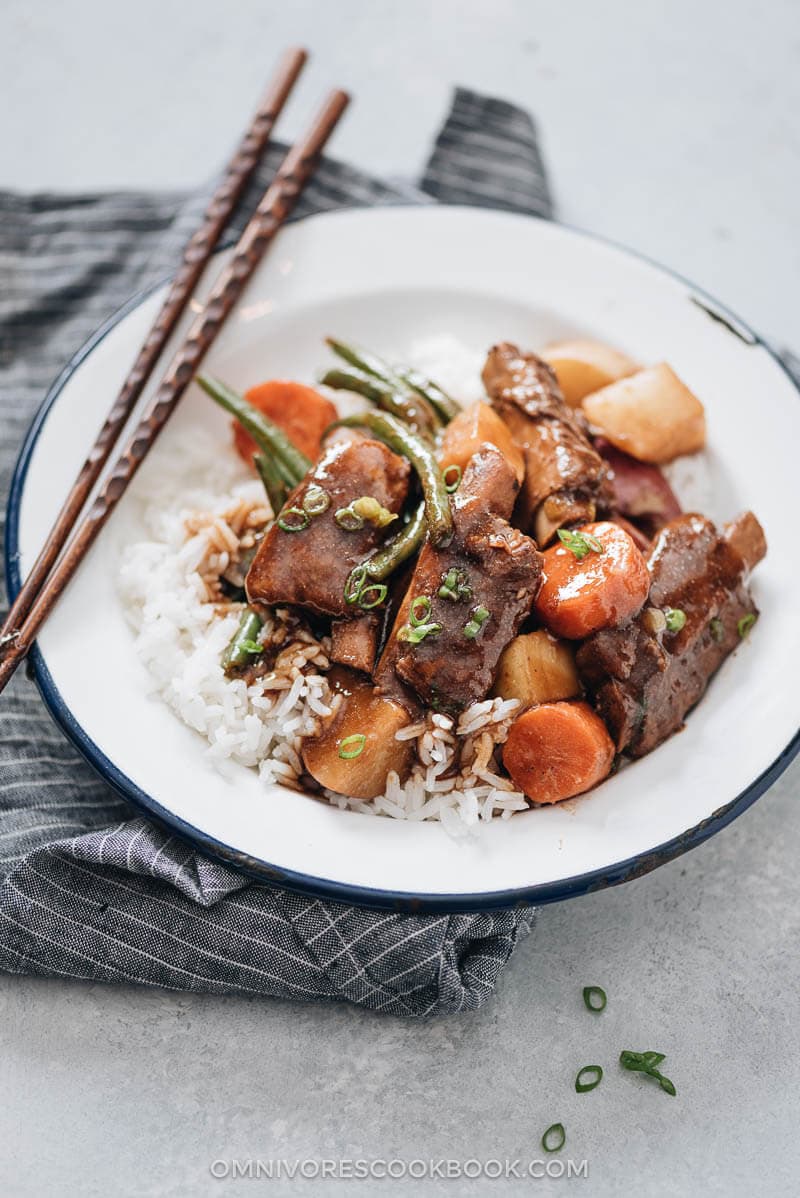
If you give this recipe a try, let us know! Leave a comment, rate it (once you’ve tried it), and take a picture and tag it @omnivorescookbook on Instagram! I’d love to see what you come up with.
Chinese Cooking Made Easy
Are you new to this website? This free email series is a great place to start. I’ll walk you through a few of my most popular recipes and show you how and why they work. You’ll quickly start to cook better Chinese food in your own kitchen.
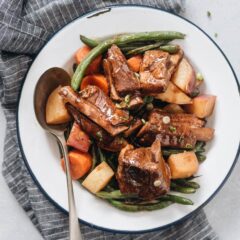
Mom’s Best Braised Pork Ribs
Ingredients
- 1 slab pork ribs (about 1.8 kg / 4 lbs) , halved crosswise and cut into one-bone sections (*Footnote 1)
- 2 " ginger , sliced
- 4 green onion , halved lengthwise
- 1 whole nutmeg (or 1 teaspoon nutmeg powder)
- 2 star anise pods
- 5 cloves
- 1/4 cup Shaoxing wine (or dry sherry)
- 3 tablespoons light soy sauce (or soy sauce)
- 1 tablespoon dark soy sauce (or soy sauce)
- 2 tablespoons granulated sugar
- 2 teaspoons salt
- 2 pieces red fermented bean curd (Optional)
- 2 tablespoons cornstarch
Vegetables (Optional)
- 2 red potatoes , chopped (or waxy potatoes)
- 3 carrots , chopped
- 1/2 lb green beans
Instructions
- Add pork ribs to a large pot and add cold water to cover. Bring to a boil over medium high heat, then turn to medium heat. Boil for 5 minutes while skimming the foam off the top with a spoon.
- Add the ginger, green onion, nutmeg, star anise, cloves, and cooking wine. Turn to low heat. Cover and simmer for 40 minutes. Stir occasionally.
- Add light soy sauce, dark soy sauce, sugar, and salt. Add the red fermented bean curd into a small bowl and add a few spoonfuls of hot broth from the pot. Smash with the back of a spoon until the bean curd dissolves. Pour back into the pot. Simmer uncovered for another 40 to 50 minutes, until pork turns tender but is not quite falling of the bone.
- (Optional) Add the vegetables. Continue simmering for 15 minutes, until the vegetables turn tender.
- Add cornstarch and 1/3 cup water into a small bowl. Whisk well until the cornstarch dissolves completely. Slowly add half of the slurry into the pot. Stir to mix well. Add more slurry and stir if you want to thicken the sauce more. Note, you might not need to add all the cornstarch slurry. (*Footnote 2)
- Serve pork ribs with steamed white rice or noodles. Enjoy!
- Store the pork ribs in an airtight container in the fridge for up to 1 week, or in the freezer for up to 1 month.
Notes
- Contrary to the common practice of selecting meaty ribs, Chinese cooking prefers smaller ribs with thin layers of meat, so the meat will be more flavorful. When you purchase the ribs, ask the butcher to saw the ribs crosswise into two shorter slabs. Then you can cut them into one-bone sections at home. Cutting the ribs into shorter sections makes serving easier and the meat more flavorful.
- Alternatively, you can transfer the pork and vegetables into a large bowl. Then reduce the sauce by turning to medium high heat for 15 to 30 minutes, until it’s thick enough to coat the back of a spoon.
Nutrition

Did you make this recipe?
I’d love to hear how it turned out for you! Please take a moment to leave a 5-star rating ⭐️ and share your thoughts in the comments further down the page. It really helps others discover the recipe too.

Jacqueline Lee
What is a ‘green onion’ please? I’m from Australia. I think it may be a shallot in Australia.
Maggie Zhu
It’s scallion. We use both in the US but I think scallion is more common.
Barman
Amazing. Ribs came out so tender. Finished them with the blowtorch. What should I do with the leftover braising liquid? It’s so tasty, I don’t want to throw it out.
Maggie Zhu
I like to save the braising liquid to cook vegetables stews. I like to cook it with potato, onion, green beans, carrot, and sometimes eggplant.
Kit
My family loved this! Thanks!
Marge
Hey, I love your Hong Shao Rou recipe and make it all the time, I now want to try it with pork ribs. However I only have half the amount of meat (2lb). Should I reduce all the ingredients in half or leave it?
I’m comparing it with the Hong Shao Rou recipe (which is also 2lb of meat) and the ingredients seems to be a similar amount vs the 4lb here.
Maggie Zhu
I think you can keep the ingredients the same, but definitely reduce the salt. Since you are using less ribs, use less water (just enough to cover the ribs) to braise them. When you add the soy sauce etc, I would skip the salt first. The fermented bean curd is salty as well (if you’re using it) and will add a lot of flavor. When the broth reduced a bit more, try it out and add salt later if needed.
PS. I used a cornstarch slurry here, but you can also reduce the broth at the end (like in Hong Shao Rou) and skip the cornstarch.
Pat
Is it green onion/ scallion or big purple onion?
Maggie Zhu
It is green onion.
Rosey
I surprised my husband with this dish tonight. He is chinese and I’m always trying to cook new things. He just so happened to buy a jar of the red fermented bean stuff so i put that in it too. We both loved it and he was impressed with my cooking lol. Thanks!
B
Hi Maggie
Thank you for this lovely recipe.
We don’t eat pork. How should the recipe be tweaked if I use chicken instead? Thanks
Maggie Zhu
You can totally use this recipe to cook chicken. I prefer bone-in leg / thigh pieces because the result is juicier.
You will need to use slightly less water (just enough to cover the pieces or a bit less), add all the seasonings at the beginning, and reduce the cooking time to about 50 mins to 1 hour until the chicken turns tender. If the sauce is still super thin at the 40 min mark, you can turn up the heat so the sauce will reduce a bit more.
Annie
So I love this recipe and it’s one of my go-to when my son is picky. However, I recently stumbled onto your tomato noodle soup too. I think it would of been great if you mentioned that the soup can use left overs from this dish. I was so excited when I found out.
Amanda
I tried this recipe thinking it would be meh… because there was no browning involved. BUT it BLEW US AWAY. it was so good. and sooo ridiculously easy!!!!!! I will be making this regularly now!
houtze
I am going to cook this for the reunion dinner. I so agree with your mom that the salty ingredient should come later. Great blog by the way !
J. C.
Hi,
I have no where to get red bean curd. I have firm tofu. Is that a suitable substitute? I’m ethnic Chinese so I know red fermented bean curb is quite salty and has the red color. Tofu isn’t the same. Should I go without it? I also don’t have nutmeg. I have some frozen stew vegetables (potatoes, carrots, celery etc.)and port rib tips. Are these enough? Your recipe looks great.
Maggie
You’re right, tofu is not the same and you should skip it. The bean curd adds a nice salty umami but it’s totally OK to make the dish without it.
Frozen stew veggies sounds good to me. You can add them at the end of the cooking because I think it takes a bit less time to cook through than fresh veggies.
Bruce
excellent dish… recipe instructions are clear & easy to follow… truly a five star yummy here.
Anna
This dish was perfect when I did not have time to defrost my spare ribs but needed a tasty dinner for myself and my 3-yr old son. I halved the portions knowing we still have left overs. Since I did not have the fermented tofu, I added miso (eye balled it). I also did not have potatoes so I used kabocha pumpkin as a starchy veggie. It was microwaved, peeled, and cut into large chunks. It was my first time making this dish and will be a regular since we both really enjoyed the dish and the ribs were so tender.
Ray
I can’t thank you enough, Maggie! This recipe is easy-to-cook (even for beginners like me), difficult to go wrong (missing an ingredien or two does not seem to affect the Wow effect), and ready-for-massive-production! LOVE IT!
Two minor questions.
1. My finished dish look a little more pale and dry comparing to your pictures. Was it because I skipped the step of thicken the sauce, and also served them directly out from the soup? It still tasts good, though.
2. Does the “blanching” concept in general imply to throw away the water after the blanching? Your recipe requires only “skimming the foam” but does not require to throw away the water. That makes your recipe as convenient as just boil. But I hope to hear your thoughts on this.
Thanks again, Maggie!
Maggie
Hi Ray, I’m glad to hear you like this dish!
To answer your question, yeah the ribs will look quite pale if you do not thicken the sauce. If it looks dry, it might be because you used a larger and leaner rib. I hope the texture still turned out tender.
As for the “blanching” yeah I guess the term I used was not accurate. My mom doesn’t discard the boiling water after skimming the foam.
Jane
Hi I don’t see footnotes. Can you give more details on cutting the pork ribs into one bone sections before cooking? Thanks!
Maggie
Hi Jane, sorry about that! I just added the footnote.
Basically you want let the butcher to split the ribs into two shorter slabs, then cut the slab into individual ribs.
The smaller ribs will absorb flavor more easily and it requires less cooking time to turn tender.
Jane Yam
Thank you! It was delicious and worked beautifully with your tomato noodle soup recipe!
David D
This recipe directed me to cook one of the best meals I’ve ever eaten.
Simple tweaks are very normal based in personal preference so
I chose to pump up the aromatics, sugar and sodium,, but good lawd, this recipe is dang near perfect!
Thanks, Maggie for sharing this. I think it’s just so warming, comforting and friggin’ delicious!
You’re lucky to have been eating this your whole life.